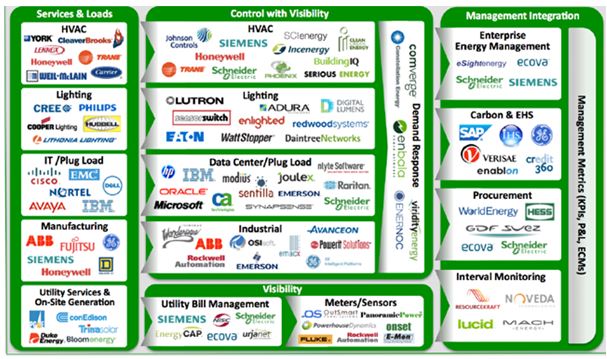|
November 2013
Article
AutomatedBuildings.com
|
[an error occurred while processing this directive]
(Click
Message to Learn More)
|
|
It is the customers not the technology
that will disrupt the industry
I
have learned it is not the technology itself that causes the change but
rather the customer’s willingness to adopt the technology that will
drive the disruption.
|

Deb Noller, CEO,
Switch Automation, Inc.
|
In June I wrote an advisory around why rising consumer expectations in
property are set to disrupt the Real Estate Sector in an extensive and
volatile manner. My arguments were that many industries have already
undergone rapid and transformational change due to a convergence of
technologies that allow customers to fundamentally alter the way they
interact with the supply chain.
Retail, entertainment, airlines and communications are all examples of
industries that have experienced a radical and tumultuous change in
every aspect of their industry from the way they go to market,
advertise, transact, deliver and support their products and services.
When an industry reaches this tipping point where the technology can
underpin the required changes in commercial activity, the businesses
that fully embrace the new paradigm tend to do spectacularly well.
Those that continue business as usual but with some concessions to
technology change falter equally as spectacularly - think Amazon versus
bricks and mortar book stores.
I still believe it to be true that the underlying technology is the
driver for any revolution in industry transformation. But this year I
have learned it is not the technology itself that causes the change but
rather the customer’s willingness to adopt the technology that will
drive the disruption.
In November 2012 we attended Coretech to learn more about the North
American Corporate Real Estate market and to promote our viewpoint that
cloud will completely transform the way building systems are deployed
in the future. Our background in controls and automation combined with
software technology had convinced us by early 2010, pre the iPad, that
controls would be cloud based in the near future.
At Coretech 2012, we were struck by the number of large USA companies
struggling to collect building operational data into a single
enterprise-wide platform. Those case studies were exemplary examples of
how specific companies had solved the world-wide problem of
inaccessible building data spread across a vast array of disparate
systems and spread sheets throughout the organization and inside every
building. While those case studies were impressive, they are
arguably customized solutions for their patient and deep-pocketed
clients. Those solutions were built with huge collaborative efforts
between client, consultants and software providers.
Coretech 2012 illuminated that there is a mammoth world-wide problem,
an opportunity equal to any we have seen in the past 20 years, so why
isn’t it solved already? There is no shortage of software and hardware
solutions for the property and building industry. Take a look at this
graphic below produced by Groom Energy; there is clearly a large number
of clever and potentially transformational solutions, some from the
large, traditional vendors and others from emerging technology
companies. Why are the customers not clamoring to adopt these emerging,
transformational technologies and deploy any number of the hundreds of
solutions already in the marketplace?

Source: Groom Energy 2013, Energy Smart Grid Vendor Landscape
I love this image – it certainly identifies one of the biggest problems
in the market, not just for the customers and vendors but also everyone
in between. This market noise is just one of the obstacles holding back
the transformation of the real estate industry.
I call this phenomenon “Software Fatigue”. A customer identifies they
have a problem and they know the organization could be more efficient
if they could find a solution that could solve their problem. The first
step is self-education so the person heading the project starts by
doing some internet-based research into possible solutions. The more
they look the worse it gets. Everyone on the project team knows about
some solution or other and when the project leader starts asking their
peers and industry cohorts, they find that everyone has either a horror
story to tell or yet another solution to add to this ever expanding
list of possible solutions that are difficult to differentiate.
And then the project stalls. How will a project manager identify the
best solution for their project if the industry itself is struggling to
differentiate all these solutions? How does one cut through the noise?
Our problem is slightly different; we have spent most of the last 12
months trying to identify the channel - what type of businesses will
address this emerging and colossal opportunity to move the property
sector into the next generation of change. The choices are widely
varied from electrical and mechanical contractors to green building
engineers, energy efficiency professionals, business consultants,
measurement and verification companies, system integrators. The list
goes on.
We are further hamstrung by the fact that IP-based systems in buildings
are not necessarily of interest to a whole market sector. Some
electrical contractors, for instance, are quite content running cables
and fitting power points. They have no interest in learning about
networking, IP technologies and so forth. Mechanical contractors
understand their business of keeping large air conditioning plants in
tune so buildings have comfort levels suitable for occupants. To
embrace change will not only require a major re-skilling in their staff
and a strategic change in their business plan but also a complete
change in their business model. There are no clearly identified market
segments for potential channel partnering and we need to find companies
that are both skilled and interested in strategic change.
Going back to the customer and their “Software Fatigue”, their problem
is that they need a software package that spans different needs and
automates as many tasks as possible while staying simple enough to use
for the various stakeholders. Things like fault detection, alerts,
scheduled reports and deep data insights are just the beginning. We
think more intelligent behavior around building data will evolve over
the next few years.
Another crucial problem, that nobody seems to have addressed so far is
seamless integration with other core business software such as ERPs
(SAP, JD Edwards, Oracle etc) which would include integration with work
order management systems, corporate finance, bill processing,
inventory, asset management, maintenance, HR (for user account
management), and so on.
Many of the current building management solutions are siloed at a
building level with building performance data and a user interface over
the top making them difficult to integrate into the business workflows
used in the real estate industry. We would argue it even goes further
than that. Currently we mostly see two separate silos within the
emerging building management industry; monitoring and analytics on one
side and controls, including demand response and load shedding, on the
other. The customer will be hard pressed to find an integrated solution
which does both in our industry. On top of that you'll find that many
software packages come with tight coupling with specific hardware,
reducing options for other integration.
[an error occurred while processing this directive]
The good news is that many of the newer entrants into the software
space understand they are only part of the overall solution and they
are building sophisticated 'hooks' or connectors between their own
software and other packages. This will be the bridging of the first gap
between the monitoring and analytics silo and the building controls
silo with the second wave bringing integration with traditional
corporate software.
The bad news is the customer needs a high level of sophisticated
knowledge to navigate through this landscape and select solutions that
will finally allow corporate real estate to be treated as part of their
business. One of the smarter things we have seen recently is large
companies adopting highly skilled building controls consultants to help
them in this process. Earlier this year we responded to a survey from
one such initiative that took us more than a week to complete. It was
by far and away the most knowledgeable, insightful and sophisticated
approach we have seen to date and I believe this is a sign of things to
come. The customer is driving the purchasing decision by enlisting
skilled advisors rather than allowing their existing service providers
to make that decision for them.
The other just as insightful thing we are seeing is large corporate
decision-makers recognizing that, here, today there is no silver
bullet. In 2013 there is no single software package that can solve all
of the functionality for all of the departments across a large
organization with hundreds or even thousands of buildings. They are
selecting solutions that can make a start on their big picture, solving
one aspect of their operations well. They take the approach that they
will solve one thing then grow the solution by introducing more
features from the same solution provider or by integrating compatible
solutions that can eventually provide them with a single seamless
solution. This is a smart approach because it contains both costs and
risk.
The shakeout will happen in the real estate and related fund management
industries. There will be players who adopt real time building
monitoring and management software at the core of their business and
build that solution out to integrate every other aspect of how they
manage buildings. When this tidal wave begins, it will be driven by the
customer and their need to run a much more highly efficient business
and the vendors, service providers, consultants servicing the real
estate sector will find enormous opportunity in the ensuing wake.
footer
[an error occurred while processing this directive]
[Click Banner To Learn More]
[Home Page] [The
Automator] [About] [Subscribe
] [Contact
Us]
